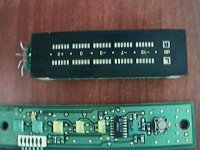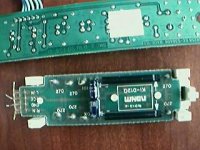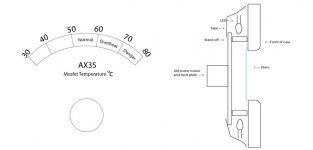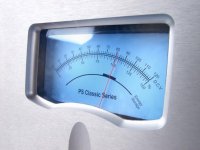Re: However
I agree with the basic method mentioned. I converted some 0-10mA meters to read 0-30V using faceplates made on a color inkjet on photo paper. It was quite nice doing it in color (green, yellow and red zones indicated on meter) and the thick glossy paper glued to the back of the existing faces. When I finish the chassis for the power supply, I plan on posting some pictures.
Sandy.
cocolino said:LBHajdu,
For example I would do this by drawing in a CAD-programm (or whatever is suitable for this) and to (laser) print on clear plastic foil (or make a film like used for PCB exposure - they are more durable!) which in turn I would apply on thin sheet aluminium which would replace the original scale (as these is fixed with 2 srews it could be replaced with some care in not to break the needle). Or maybe even better, depending on how the backside of the original scale looks like, it might be used again be simply turning around. Also the original scale (respectively the backside of it) could be oversprayed in a scale background colour of Your choice.
I agree with the basic method mentioned. I converted some 0-10mA meters to read 0-30V using faceplates made on a color inkjet on photo paper. It was quite nice doing it in color (green, yellow and red zones indicated on meter) and the thick glossy paper glued to the back of the existing faces. When I finish the chassis for the power supply, I plan on posting some pictures.
Sandy.
Ok! I know it doesn't have the visiual impact of a good old analog
meter but a digital outside themoter from... I hate to say the word but here goes..... Radio Shack on sale for about $10 US
would fit the bill.
Regards,
Woody
meter but a digital outside themoter from... I hate to say the word but here goes..... Radio Shack on sale for about $10 US
would fit the bill.
Regards,
Woody
Member
Joined 2002
Here is the first draft of the cutout I would like to use in my amp. The original file is a PDF file which prints out without any pixilation because it’s stored as vector art. If someone needs this file I will post it, but the size will probably have to be scaled to you’re specific meter. Those whose minds run to such things may wish to figure out the best way to print out this label and attach it to the back plate. I am leaving it in black and white so it can be printed out with a laser printer. I was <b>really, really</b> hoping that someone would comment on the circuit I submitted. Would I be right in assuming that it the original ax circuit Q2 and Q11 get hotter then Q1 and Q10?
Next to that there is a diagram of how I plant to remount the meter. The only parts of the old meter I’m keeping are the back plate and the motor system. Costly $60 meter are not really needed here. The cheap plastic ones come apart whit less trouble and if you break the delicate motor system you’ve only wasted about $20. In more expansive meters most of the cost goes into the outer case. The adjustment screw and spring are usually also made of slightly thicker steel so when you adjust the meter to stay exactly at zero when there is no current applied to it; it stays there. Some of the Simpson meters have that ace of spades shape on the top of the needle. I think they look really nice, but not for this application.
Peter,
I have a barbecue gage; it only has 3 hashes on it. They are labels fish, chicken, and beef. (joke)
JasonL,
Did you know that there is a full schematic for the circuit you want to incorporate in to your amp using 20 LEDs on the LM35 speck sheet?
Cocolino,
Thanks for the meter pic’s.
Levente Hajdu
Next to that there is a diagram of how I plant to remount the meter. The only parts of the old meter I’m keeping are the back plate and the motor system. Costly $60 meter are not really needed here. The cheap plastic ones come apart whit less trouble and if you break the delicate motor system you’ve only wasted about $20. In more expansive meters most of the cost goes into the outer case. The adjustment screw and spring are usually also made of slightly thicker steel so when you adjust the meter to stay exactly at zero when there is no current applied to it; it stays there. Some of the Simpson meters have that ace of spades shape on the top of the needle. I think they look really nice, but not for this application.
Peter,
I have a barbecue gage; it only has 3 hashes on it. They are labels fish, chicken, and beef. (joke)
JasonL,
Did you know that there is a full schematic for the circuit you want to incorporate in to your amp using 20 LEDs on the LM35 speck sheet?
Cocolino,
Thanks for the meter pic’s.
Levente Hajdu
Attachments
Member
Joined 2002
Member
Joined 2002
I was going to use any lm devices i have a book here that uses voltage to increse the leds status i was going to build a circuit that would use a therminster. when the amp got hot the voltage went up and lit up the led's more.
Here is another circuit, a little simpler this time. Comments to get this circuit going would really be appreciated along with some values for parts. Just fill in the block “x” with anything from the right. Don’t forget thermistor start to heat up when you run too much power through them (look at the speck sheet). Also take a look at “National Semiconductor’s Temperature Sensor Handbook” online. For things whose resistants goes up as they get hotter (like the LM336) flip the positions of “x” and R1.
Woops, I forgot to add a diode on the line to the meter, just in case the polarity flips.
Woops, I forgot to add a diode on the line to the meter, just in case the polarity flips.
Attachments
LBH -- that's the expensive way
why not just use one LM35, an inexpensive op amp and a transistor, or you can use the LM35 to bias the adjust pin of an LM317 regulator.
LM35's are too expensive to parallel for more current. (if that's what you're drivign at.)
why not just use one LM35, an inexpensive op amp and a transistor, or you can use the LM35 to bias the adjust pin of an LM317 regulator.
LM35's are too expensive to parallel for more current. (if that's what you're drivign at.)
This shop here has quite a nice range of vu-meters :
http://www.meterdistributor.com/TripPages/pg15.htm
Jens
http://www.meterdistributor.com/TripPages/pg15.htm
Jens
- Status
- Not open for further replies.
- Home
- Amplifiers
- Pass Labs
- A temperature meter for my AX




